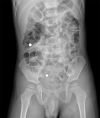Surgical treatment of multiple magnet ingestion in children: A single-center study
- PMID: 33344597
- PMCID: PMC7723714
- DOI: 10.12998/wjcc.v8.i23.5988
Surgical treatment of multiple magnet ingestion in children: A single-center study
Abstract
Background: Since 2017, the number of magnet ingestion cases has increased year over year in our hospital. Almost all of the ingested magnetic foreign bodies were magnetic beads, and most of the patients experienced intestinal perforations, causing substantial damage.
Aim: To summarize our experience with surgical treatment of multiple magnet ingestion in children.
Methods: The data for general surgeries were collected from January 2010 to April 2020, and the clinical characteristics, treatment methods, and outcomes were summarized and analyzed. Several typical cases were selected and discussed.
Results: Fifty-six cases of ingested magnetic foreign bodies were collected, of which 47 were magnetic beads. The average patient age was 4.7 ± 3.0 years old. The number of ingested magnetic foreign bodies ranged from 2 to 73. There were 26 cases with symptoms at the time of admission, including two cases of shock. Thirteen patients were discharged successfully following conservative treatment and 43 were treated by surgery. Laparotomy was the main method of operation. Laparoscopy was used in four cases, of which three were converted to open surgery, and one was treated successfully using surgery through the navel. Postoperative complications occurred in seven cases, incision infections were observed in six, and adhesive ileus was observed in one.
Conclusion: Clinicians need to summarize their experiences with treating magnetic foreign body ingestions in detail and carry out clinical research to reduce the damage to children.
Keywords: Buckyball; Children; Intestinal perforation; Magnetic bead; Magnetic foreign body; Pediatric surgery.
©The Author(s) 2020. Published by Baishideng Publishing Group Inc. All rights reserved.
Conflict of interest statement
Conflict-of-interest statement: There are no conflicts of interest to report.
Figures





References
-
- Bauman B, McEachron K, Goldman D, Louiselle A, Zheng E, Mills D, Louie J, Segura B. Emergency Management of the Ingested Magnet: An Algorithmic Approach. Pediatr Emerg Care. 2019;35:e141–e144. - PubMed
-
- Eisen GM, Baron TH, Dominitz JA, Faigel DO, Goldstein JL, Johanson JF, Mallery JS, Raddawi HM, Vargo JJ 2nd, Waring JP, Fanelli RD, Wheeler-Harbough J. American Society for Gastrointestinal Endoscopy. Guideline for the management of ingested foreign bodies. Gastrointest Endosc. 2002;55:802–806. - PubMed
-
- Kramer RE, Lerner DG, Lin T, Manfredi M, Shah M, Stephen TC, Gibbons TE, Pall H, Sahn B, McOmber M, Zacur G, Friedlander J, Quiros AJ, Fishman DS, Mamula P North American Society for Pediatric Gastroenterology, Hepatology, and Nutrition Endoscopy Committee. Management of ingested foreign bodies in children: a clinical report of the NASPGHAN Endoscopy Committee. J Pediatr Gastroenterol Nutr. 2015;60:562–574. - PubMed
-
- Hussain SZ, Bousvaros A, Gilger M, Mamula P, Gupta S, Kramer R, Noel RA. Management of ingested magnets in children. J Pediatr Gastroenterol Nutr. 2012;55:239–242. - PubMed
LinkOut - more resources
Full Text Sources
Miscellaneous

